About 35 minutes into Michael Fiore’s documentary Veselka: The Rainbow On the Corner at the Center of the World, Ukrainian members of the restaurant staff hustle to get food to customers. As they do, they talk about their boss, Veselka owner Jason Birchard, and his ability to communicate in their language. When Fiore asks one of them, Dima, for an interview, he says, “No. Thank you. I’m not in the mood.” Fiore says he understands, it’s busy. “I’m not busy,” Dima replies. “The first nine days (of the war), I lost nine friends.”
It’s 11 days into the war in Ukraine, and what was to this point a film about a family business and local institution suddenly becomes something much different: a powerful document of a year in the life of a community 5,000 miles from — but very much at the center of — the worst armed conflict in Europe since World War II.
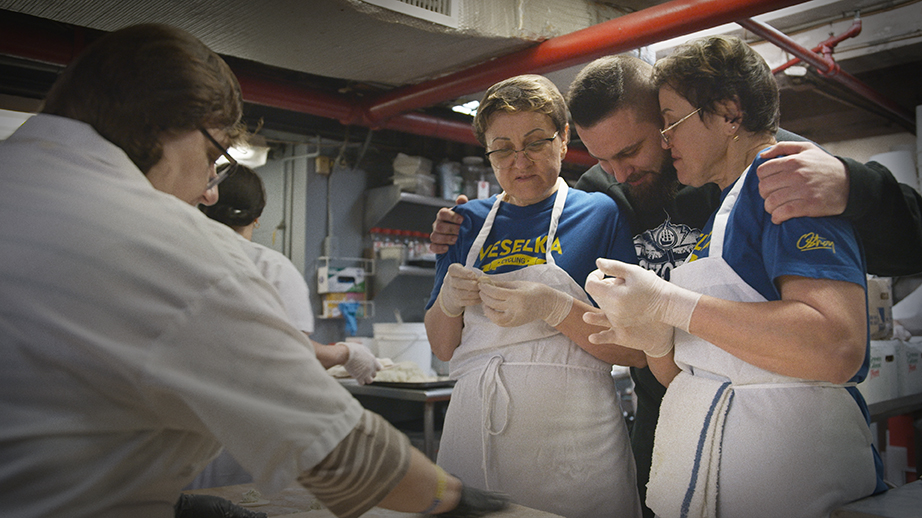
Veselka originally debuted in February at the Santa Barbara Film Festival before screening around the country. It’s now available via the Apple TV app, various streaming services, and Blu-Ray. Narrated by David Duchovny with a soundtrack featuring saxophonist David Sanborn — one of the last things he did before he died in May at 78 — the film began as a more Ken Burns-like documentary about the Village institution. Opened in 1954 by Ukrainian refugee Wolodymyr Darmochwal as a candy store and gathering point for other displaced Ukranians, Veselka grew into a restaurant and a Village staple as Wolodymyr’s son-in-law Tom Birchard took over the business, followed by Tom’s son Jason.
Fiore says Veselka was originally conceived as a film examining the history and family and community dynamics that shaped, and continue to shape, Veselka. But then Russia invaded Ukraine, and it became a very different film. Tom and Jason’s story needed to coexist alongside those of Dima and Vitalii, another long-time employee and native Ukrainian, who both struggle with being so far from home, the toll the war has taken on their families, and getting their loved ones out of the country. The more straightforward documentary Fiore envisioned suddenly became more visceral and urgent.
The director spoke with the Star-Revue about having a front-row seat to history, how he hopes the film can impact the ongoing conversation about America’s support for Ukraine, and the film’s brief but infamous appearance by Mayor Eric Adams. Our conversation has been edited for length and clarity.
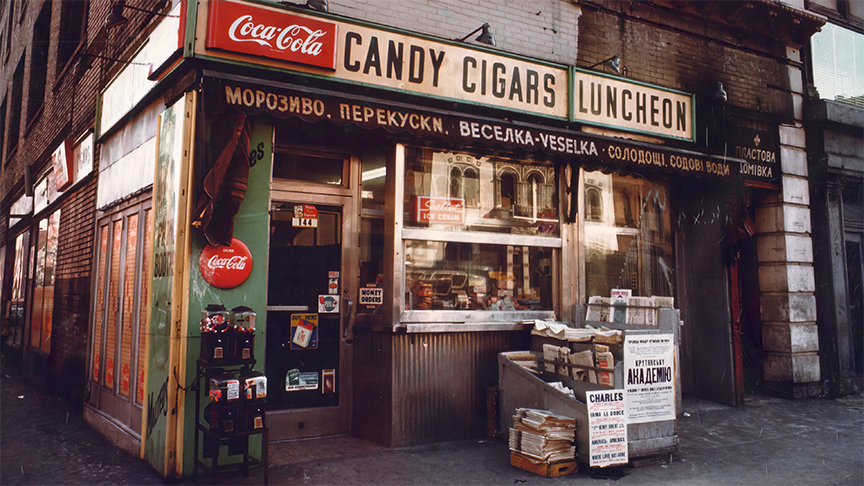
Why make a documentary about Veselka?
When the pandemic happened, a lot of my production work dried up and I was desperately looking for something controlled to be able to work on. I’d never met Tom or Jason, but we had colleagues in common and I got this introduction in November 2021. I knew the back-of-the menu story of it being owned by three generations, but I wanted a better understanding of it, to get a sense of who they were and to figure out if there was an angle there. Soon after our meeting, I pitched them an idea where the core idea was family, fathers and sons, and community through good times and bad, and how the power of food brings people together. It was going to dissect the neighborhood even more, and probably be even more Ken Burns-y, in a way.
They sat on the idea for a few months, and then in January 2022, when the news started talking about people training in Ukraine to potentially fight in a war, I was, like, “Whoa, what’s going on?” I emailed them and said, you know, God forbid that war happens, but there might be parallels to explore by way of Wolodymyr becoming a refugee during World War Two and coming to New York and opening up the storefront. And they sat on that for a couple weeks, and then finally, a few days into the war, they said, “Okay, we feel comfortable with you, you can start filming. But be very delicate.”
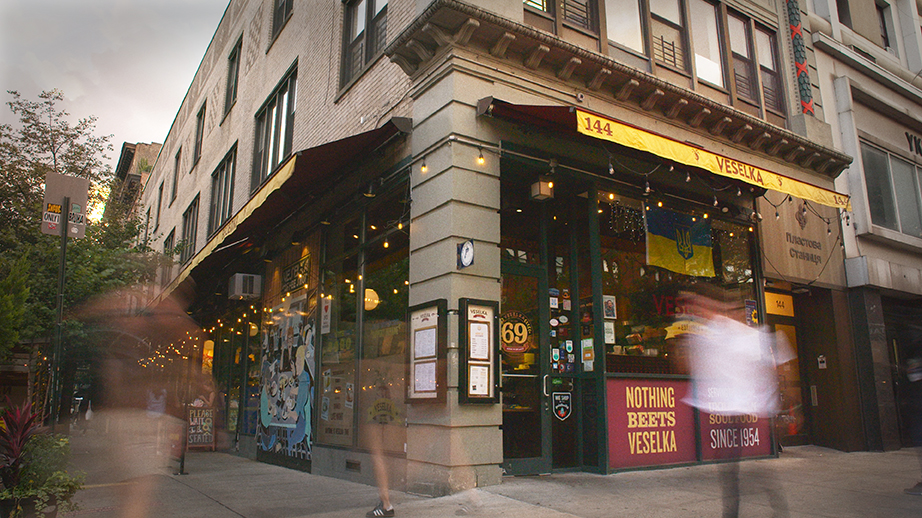
This isn’t meant to be insensitive, but is the version of the film that resulted from the outbreak of the war better than the one you originally conceived?
I mean, look, I would trade the war never happening for the alternate version, without a doubt. But since it has occurred, it did give more resonance to the core themes of family and community coming together.
And you didn’t lose that core multi-generational idea. The relationship between Jason and Tom is still there, but you also have this maybe more interesting mirror in the way some of the Veselka staff bring their family to the U.S. from Ukraine. Rather than the older generation handing the world over to their kids, it’s the younger generation rallying to protect their parents and grandparents.
I appreciate you recognizing that. I saw Vitalii and his mom’s story as a mirror of Wolodymyr coming here in the late 1940s. So in weighing and measuring the emphasis on the past versus the present, I made a very calculated choice that the movie not be about Wolodymyr. It’s really more about the now. He’s the cornerstone to the story, setting up Veselka. But then it’s more about Tom taking it over and the strains on him and his family through the decades for him to get it to where it is. And then it’s Jason learning from his father not being there to now being a father himself, in a way, to Vitalii and these other gentlemen, the way his dad was not with him. So to me, in telling that story of Vitalii and his mom, you’re really telling Wolodymyr’s story, too. You’re seeing in real time what these refugees in the ‘40s were going through.
This is a film about a restaurant and a business. Even with its history and storylines it has, how do you make this so it doesn’t feel like a commercial?
That was always something that I was really, really aware of. The way I avoided it was very consciously saying I wasn’t going to interview the public and get their feelings about the restaurant, I wasn’t going to show news clips talking about Veselka, and I wasn’t going to show all the Hollywood movies that have chosen to film in there. My goal with this movie is that you experience a moment in time with the people involved in the events in a way where you come off feeling like you’ve been with them for over 90 minutes. I don’t have to gild the lily if you’re just feeling the real and honest vibe of the space, the people, whatever’s going on.
The first bit of the film, prior to the war starting, where we get the history and a taste of the place, feels like it’s doing a lot of that important scene setting.
And by the way, that first act is completely different tonally. That was a very conscious decision, where it sets itself up to be that Ken Burns-like film where we go back in time with photos and imagery from the past and you’re establishing the different “characters.” But then once the war starts and we’re really thrown into it by the end of Act One, you realize the severity of how this is impacting people like Vitalii and Dima. When Dima reveals to me that nine of his friends died in the first nine days of the war, you’re seeing in real time the evolution I had as a storyteller, where I realized, from there on, it has to be a different movie than what you just experienced. And that’s when Act Two and Three become completely cinéma vérité and we don’t really do a lot of looking back.
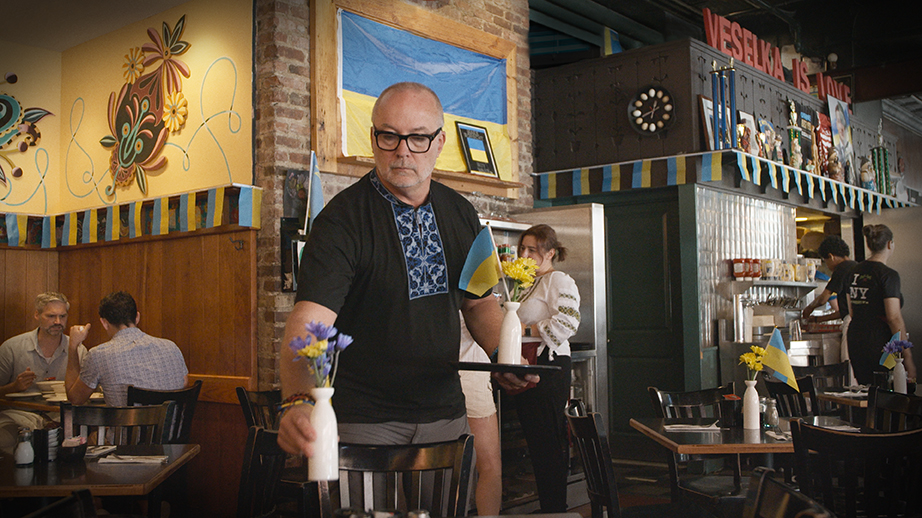
When Dima tells you about his friends, how did hearing that hit you?
If I recall correctly, I just told our camera operator, like, I motioned for them to tilt the cameras down and turn them off, and we basically wrapped for the day. At that point, we realized we can’t overstay our welcome on any day because of the severity of what this is. I didn’t know how long I was going to be there with them. Would this war be over in two weeks? Would it be over in two months? No one could predict. The sentiment towards the war was changing, and it was changing very quickly, and it was starting to become polarized in our country about support. So that’s when I said I need to get this movie done and out as quickly as possible, so that it was a symbol of support, so Ukrainians would see there’s a lot of people that still care and want to help.
We’re speaking roughly two months from the third anniversary of the war. A lot can change in two months. But what role do you see this film playing now? Because it’s almost worse now, in this country, in terms of the conversation about supporting Ukraine. It often seems like there is no conversation.
And from all the comments you’re hearing out of the next administration, they may pull back on funding, so there would be less support, at least from the government. The good news is, Veselka is continuing its support. They work with Razom and a bunch of other Ukraine-focused nonprofits to continue to give money. By the time the film was released, they had raised something like $650,000 in in-kind monies and goods. Since the movie came out theatrically almost a year ago, they’re up to almost a million dollars. My goal was always to tell a story that would allow people in Ukraine to know that there is this place they can call home in the United States, whether they want to visit or move out of Ukraine; that there is a community that’s been there for them for over 100 years and would welcome them in a heartbeat. And, specifically, Veselka always will.
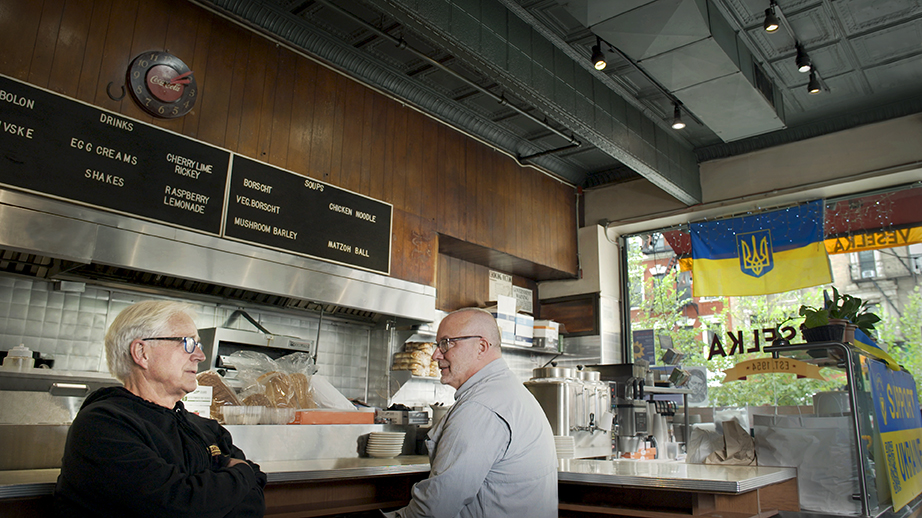
Did the film play in Ukraine?
We opened in Ukraine in six cinemas in four cities: Kyiv, Odessa, Kharkiv, and Lviv. On the opening night in Kyiv, Vitalii’s dad went and he sent back a photograph of roughly 50 people that had attended in front of the movie screen. As a storyteller, that moved me like you couldn’t believe. That was the core audience. And I was told that during the war, if you see 10 people total in any movie theater, that’s a lot. The fact that we had 50 people in just one screening was amazing.
As part of that Ukraine release, we wanted the baseball team to come to the opening. We wanted to celebrate them. Unbeknownst to me, the way they recruit or draft soldiers is by grabbing them right off the street. If you were a young male at a coffee shop, if somebody in the military saw you, they could grab you and throw you in the front lines. The baseball team didn’t feel comfortable going out to the movie theater because they were concerned that they would be a focus and be taken. So of the 50 people that were in the audience, two of them were baseball players. The majority were 12-year-old kids from a youth baseball league. My hope is that those kids in that audience saw this and felt, Oh, there’s a place in the United States that really does care for me and the Ukrainian people.
In terms of the domestic audience, you mentioned before our conversation that the film is in the top 10 on Apple TV+. How do you leverage that visibility and popularity so the film has a voice in the ongoing debate about the U.S. and its influence in the war?
One thing I want to avoid is making the movie feel like it’s too local. Even though this story takes place in a New York restaurant, there’s so many universal themes of paying it forward, staying connected to your community, and just helping your community through good times and bad. We cite multiple times where Veselka over the decades, from 9/11 to Superstorm Sandy and now the war, has just always been there, no matter what, for the local community and now beyond to Ukraine. That’s the important message here that goes beyond even this war. We could all be the rainbow on the corner at the center of the world. We can all do our part to pay it forward and give back to people, to make not only our local communities stronger but the country a stronger place.
Not to get too local, but there is a moment in the film that will have particular resonance for New Yorkers, and that’s the scene where Mayor Eric Adams meets with Jason and Tom and official representatives of Ukraine at Veselka. He sits across the table from the Ukrainian consul who is telling the mayor all these awful stories about the experience on the ground, the realities in the country—and Adams is giving thumbs up, smiling and mugging for the cameras outside the windows. It’s like he’s not even in the same universe as the others at that table.
They were treating that appearance as a duality, where they were covering both the end of the mask mandate and also talking to Ukraine’s consul general. Adams had no focus. He was bouncing around all these different ideas. If I had put in more of what we had, that appearance would have been like an unelection committee. He looked even worse. Not that I was trying to make him look good, but it was like I was beating a dead horse after a while. Okay, we get it, it’s more about him and not about the situation at hand. In that moment, I couldn’t believe it. The mayor knew our cameras were there. He had our microphone on him. Our cameras were four feet from his face. His team had approved everything. It’s not like we ambushed him. This is who he is.
I always say that the storytelling gods sometimes grant you everything. And in this movie, I had a few of those beautiful, well-timed moments. And in the case of Mayor Adams, it made me realize what the story was on the second day of filming. I realized, and I say it by way of Tom and Jason in that sequence at the start of Act Two, that Jason was going to have to now be the local leader for Ukraine. It became very apparent in that moment, and it really sets Jason and the audience off on this path, this new journey, by way of seeing that the mayor wasn’t fully listening and fully supportive in that moment.
What tips that moment over into almost tragedy is Adams’ fundamental unseriousness. It plays like a microcosm of the experience people are having everywhere — Ukrainians trying to explain just how horrible the situation is, and the people and leaders they’re trying to reach just aren’t listening.
That’s exactly right. And, again, on a more universal level, it’s a reminder to all of us that we can’t look to our local or national officials, no matter what party we’re a part of, to be the “leaders.” It really needs to go back where we care about our little, intimate community, whether we live in a big neighborhood in Manhattan or a small town in the middle of Texas. We need to care more about what’s in our periphery and what’s in front of us and raise people up. In the case of Jason and Tom and Veselka, they feed the community and the community feeds them back. It’s a mutual feeding. And people recognize one another’s importance in this ecosystem, that the community is there as much for Tom and Jason and the restaurant as Tom and Jason is there for the community.
“Veselka: The Rainbow on the Corner at the Center of the World” is now available via the Apple TV app, major services, and Blu-Ray. Visit veselkamovie.com for more information. Trailer here: https://youtu.be/h2vhjuBUG7Y


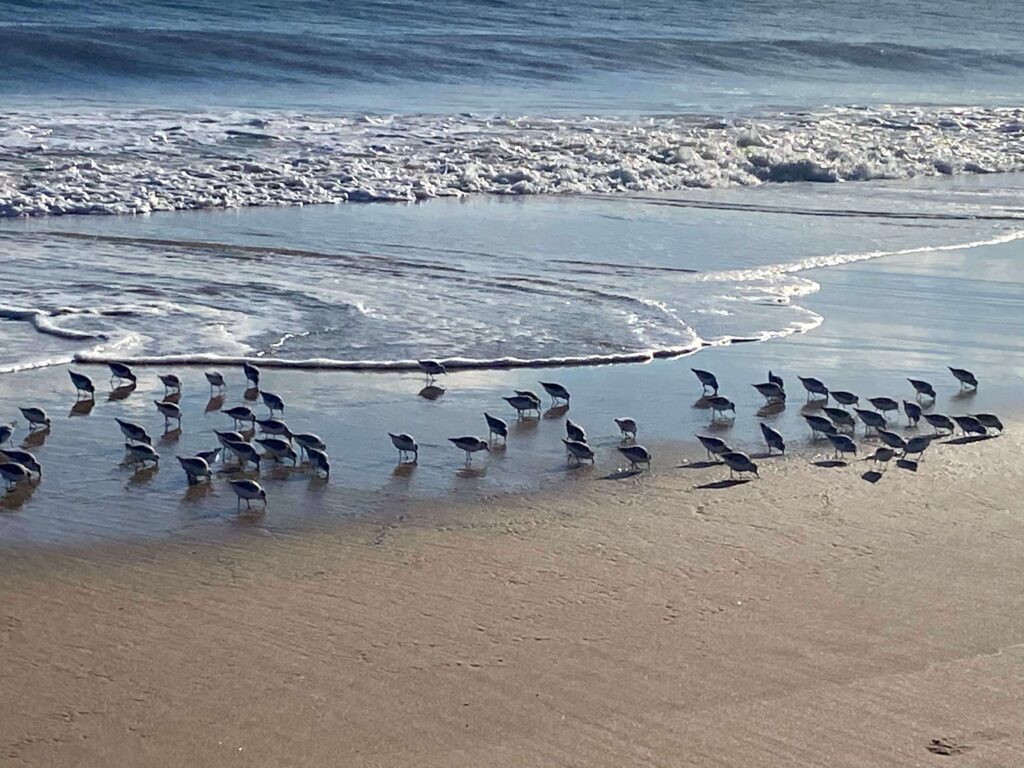

r16uaf